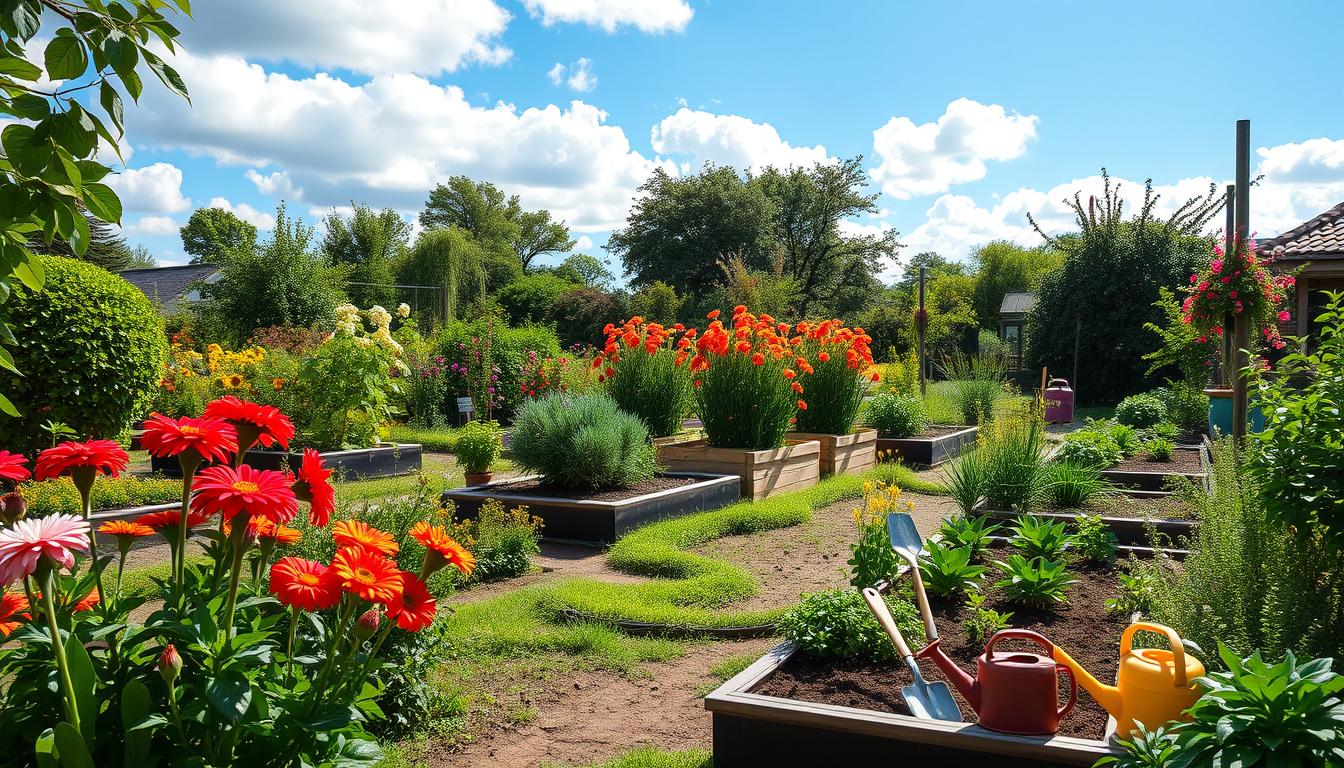I’m excited to share my journey with you. I hope to inspire you to start your own gardening adventure. Gardening 101 is about taking small steps to create a beautiful outdoor space.
As I began my gardening journey, I learned it’s not just about planting seeds. It’s about understanding the basics, choosing the right plants, and caring for your garden. With these simple steps, you can create a stunning garden, even if you’re new to gardening 101.
In this article, I’ll share my experiences and tips on starting your garden. We’ll cover preparing your garden soil to maintaining it with beginner gardening tips. Whether you have a small balcony or a large backyard, I’m sure you’ll find something inspiring. Start gardening today and master gardening 101.
Understanding the Basics of Gardening
Gardening is a great hobby that lets you connect with nature. It also offers many health benefits. For beginners, it’s key to learn about sunlight, water, and soil quality. Knowing about different plants and how to care for them is also important.
To start, you need to learn the gardening basics. This includes knowing about tools and techniques. Mastering skills like planting, watering, and fertilizing will help you grow a beautiful garden.
What is Gardening?
Gardening is about growing plants like flowers, vegetables, and fruits. It involves preparing the soil, planting seeds, and caring for them. This helps them grow well.
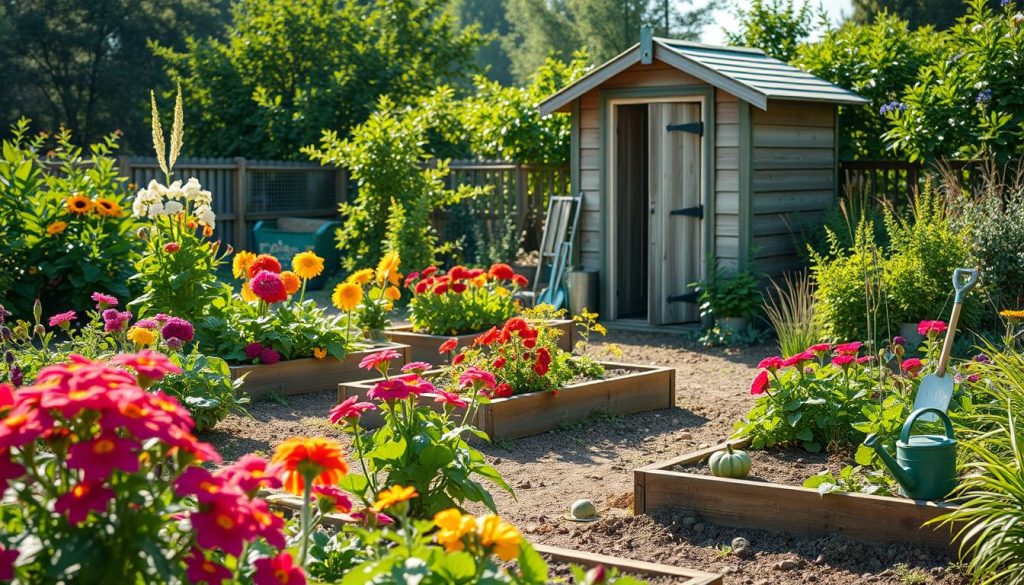
Why Gardening is Important
Gardening is vital for many reasons. It provides fresh food, improves air quality, and builds community. It also boosts physical and mental health by reducing stress and improving mood.
My Gardening Journey
As a beginner, I’ve found gardening to be rewarding. It requires patience, dedication, and a desire to learn. By starting with the basics and growing my skills, I’ve created a beautiful garden. It brings me joy and fulfillment.
Choosing the Right Plants for Your Garden
Starting a garden can be overwhelming, especially for beginners. With so many plants to choose from, it’s key to think about climate, sunlight, and space. This ensures your plants will do well.
Assessing Your Climate Zone
To pick the right plants, first figure out your climate zone. This helps you choose plants that can handle your area’s weather. Local nurseries or gardening stores can give you advice on the best plants for your zone.
Considerations for Sunlight and Space
Think about how much sunlight and space your garden has. Some plants need lots of sun, while others prefer shade. Choose plants that match your garden’s conditions. Here are some easy plants for beginners:
- Herbs such as basil and mint
- Vegetables like tomatoes and cucumbers
- Flowers such as roses and sunflowers
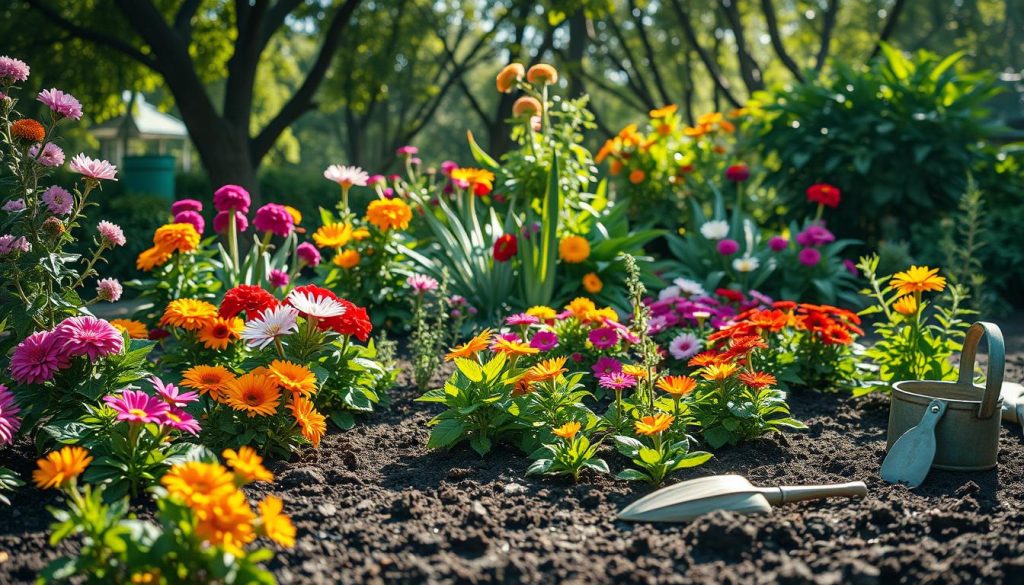
Popular Plants for Beginners
These plants are easy to grow and need little care. They’re great for new gardeners. By picking the right plants, you’ll create a beautiful garden, whether you’re starting fresh or need beginner tips.
Preparing Your Garden Soil
Starting a garden? Preparing the soil is key for a healthy garden. Simple steps can help your plants grow well. Here’s how to get your garden soil ready.
Testing Your Soil Quality
First, test your soil quality. You can buy a kit or send a sample to a lab. This tells you about your soil’s pH and nutrients.
Amending Soil for Optimal Growth
After testing, amend your soil for better growth. Add compost or manure to improve its structure and fertility. Fertilizers can also provide the nutrients plants need.
The Importance of Drainage
Drainage is crucial for your soil. Bad drainage can cause waterlogged soil, harming your plants. Improve it with organic matter or a drainage system.
By following these tips, you can make your garden soil perfect for plants. Test, amend, and ensure good drainage. Your garden will thank you.
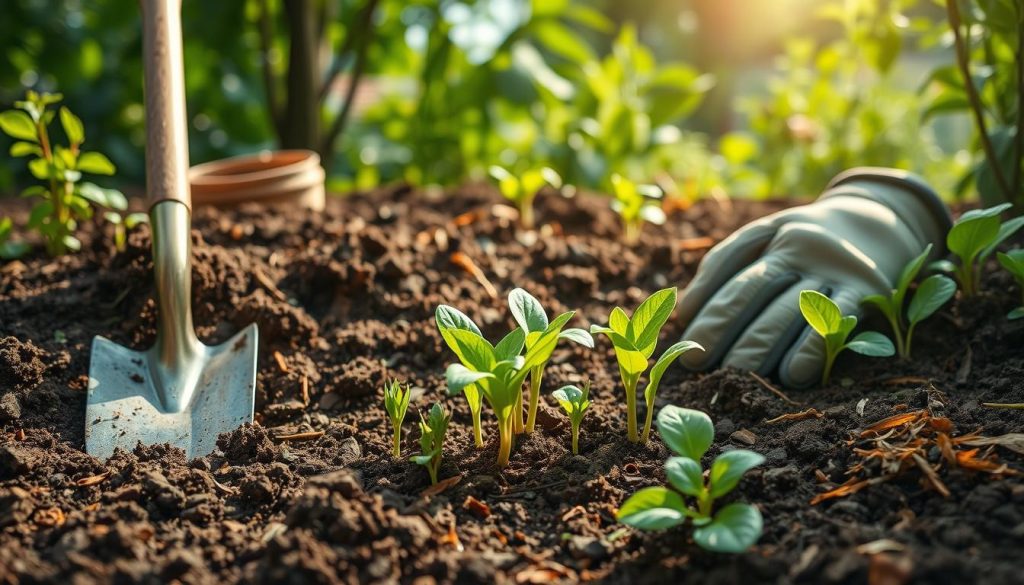
| Soil Type | pH Level | Nutrient Content |
|---|---|---|
| Clay | 6.0-7.0 | High in nutrients |
| Sandy | 7.0-8.0 | Low in nutrients |
| Loam | 6.0-7.0 | Balance of nutrients |
Essential Gardening Tools I Use
Having the right tools is key for a great gardening experience. For beginners, the right tools are essential. I’ll share my top picks, from hand tools to power tools that simplify gardening.
Must-Have Hand Tools
For gardening 101, you need a trowel, pruners, and gloves. These tools help with planting, pruning, and keeping your hands safe from thorns and dirt.
Power Tools That Make Gardening Easier
Power tools like lawn mowers and hedge trimmers make gardening easier. They help keep your lawn and hedges in shape, saving you time and effort.
Organizing Your Gardening Supplies
Keeping your gardening supplies organized is important. I use a gardening cart to store my tools and supplies. I also have a specific area in my garden for them.
Here’s a list of my essential gardening tools:
- Trowel
- Pruners
- Gloves
- Lawn mower
- Hedge trimmer
- Gardening cart
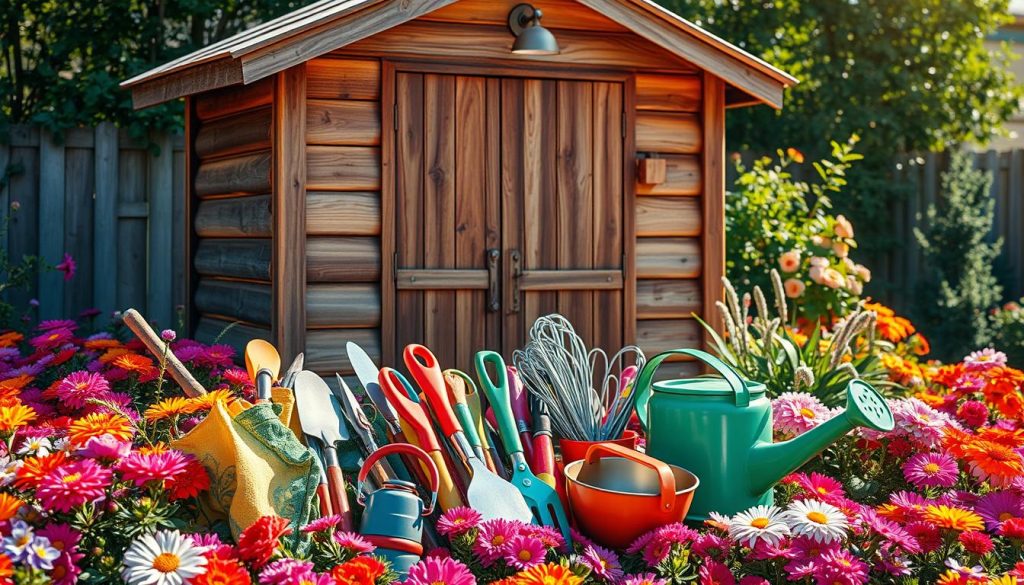
Planting Techniques for Success
As a beginner gardener, I’ve learned that planting is key. The right techniques can help your plants thrive. Here, I’ll share tips and basics to help you plant like a pro.
When planting, remember a few important things. Here are some tips to get you started:
- Understand the planting depth for your specific plants
- Leave proper spacing between plants to prevent overcrowding
- Water your plants immediately after planting to settle the soil
By following these tips, you’ll be on your way to a beautiful garden. Always remember to prepare the soil and choose the right plants for your climate.
Understanding Planting Depth
Planting depth is key for your plants’ health. Check the specific depth for each plant to get the best results.
Proper Spacing Between Plants
Proper spacing is vital for healthy growth. Leave enough space for air and sunlight to reach each plant.
Watering Immediately After Planting
Watering right after planting helps the soil settle. Water well, but avoid too much to prevent root rot.
Maintaining Your Garden: Watering and Fertilizing
As I explore easy gardening for beginners, I’ve found that watering and fertilizing are key. These steps are vital for your plants’ health and growth. They’re essential when you start your garden.
To keep my garden healthy, I’ve made a watering schedule. It considers the weather and soil type. This schedule helps me avoid too much water, which harms plants. I also use organic fertilizers to feed my plants.
Creating a Watering Schedule
For beginners, a watering schedule is crucial. It helps you know when to water your plants. This ensures they get the right moisture. Here are some tips for your schedule:
- Check the soil moisture by inserting your finger into the soil up to the knuckle
- Water your plants in the morning or early afternoon to allow the plants to absorb the water throughout the day
- Avoid getting water on the leaves to prevent fungal diseases
The Benefits of Organic Fertilizers
Organic fertilizers are great for starting a garden. They give plants natural nutrients for growth. Here are some benefits:
- Improved soil structure and fertility
- Increased crop yields
- Reduced environmental pollution
Signs Your Plants Need More Nutrition
If you see these signs, your plants might need more nutrients:
- Yellowing or discolored leaves
- Slow growth or stunted development
- Increased susceptibility to pests and diseases
By following these tips, you can keep your garden healthy. Enjoy the benefits of easy gardening for beginners and starting a garden.
Pest and Weed Management Strategies
Starting out in gardening, I quickly faced the challenge of pests and weeds. I learned simple ways to manage them. First, I identified common pests like aphids, whiteflies, and spider mites.
To control these pests, I turned to natural methods. Neem oil, insecticidal soap, and diatomaceous earth are effective and safe for the environment. For instance, neem oil fights off aphids and whiteflies. Insecticidal soap is great for soft-bodied pests like aphids and spider mites.
Identifying Common Garden Pests
- Aphids: small, soft-bodied insects that feed on plant sap
- Whiteflies: tiny, winged insects that feed on plant sap
- Spider mites: small, spider-like insects that feed on plant sap
Natural Pest Control Options
Using natural pest control is key. I also prevent pests and weeds with simple gardening tricks. Physical barriers, like fine mesh or netting, keep pests away from plants.
Weeding Techniques That Work
Weeding is crucial in gardening. I use mulching and hand-weeding to keep weeds at bay. Mulching stops weeds from growing, and hand-weeding removes them.
| Weeding Technique | Description |
|---|---|
| Mulching | Applying a layer of organic material, such as wood chips or straw, to suppress weed growth |
| Hand-weeding | Physically removing weeds from the garden using a tool, such as a hoe or a hand-weeder |
The Importance of Pruning and Deadheading
As a gardener, I’ve learned that pruning and deadheading are key. They help plants grow well and bloom more. With some advice and easy strategies, you can do these tasks well and make your garden lively.
Pruning and deadheading might look hard, but they’re not. With the right tools and a bit of knowledge, they’re simple and rewarding. Here are some tips to start:
- Prune your plants during the dormant season to minimize stress and prevent disease.
- Deadhead flowers regularly to encourage blooming and prevent seed production.
- Use sharp, clean tools to prevent spreading disease and making clean cuts.
By following these tips and using the right tools, you can become a pro at pruning and deadheading. Enjoy a beautiful, thriving garden. Always follow beginner-friendly gardening strategies and seek advice when needed.
Seasonal Gardening Tips
Starting with gardening 101 means knowing each season’s challenges and chances. To get the most from your garden, follow beginner tips for each time of year.
Here are some key seasonal gardening tips to keep in mind:
- Prepare for spring planting by cleaning up your garden beds and adding fresh soil amendments.
- Implement summer maintenance strategies, such as regular watering and fertilizing, to keep your plants healthy and thriving.
- Focus on fall cleanup and winter preparation, including pruning and protecting your plants from harsh weather conditions.
By following these seasonal gardening tips, you’ll be well on your way to creating a beautiful and thriving garden, even as a beginner in gardening 101. Remember to stay flexible and adapt to the unique conditions of each season, and don’t hesitate to seek out additional beginner gardening tips as you continue on your gardening journey.
Sharing the Joy of Gardening
Gardening is a hobby that everyone can enjoy, no matter their age or background. As we wrap up our guide to gardening for beginners, I urge you to spread the joy of gardening basics. Teaching kids about nature and growing plants is a great way to do this.
Joining local gardening clubs is also a great idea. It lets you meet others who love gardening, learn new things, and help with community gardens. Sharing a love for easy gardening can make you feel really connected.
Think about starting or joining a community garden in your area. These gardens are great for growing your own food and bring people together. Seeing kids enjoy planting and harvesting their own food is incredibly rewarding.

